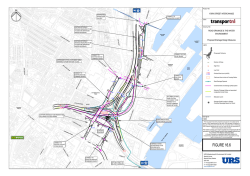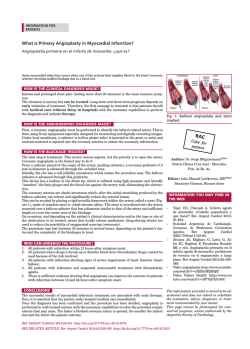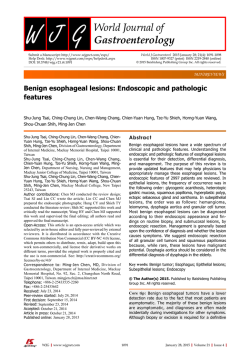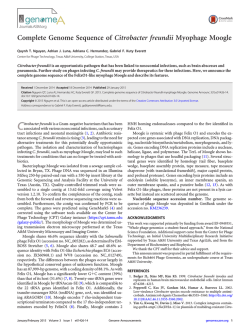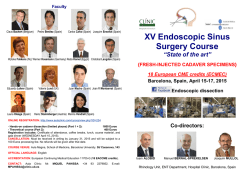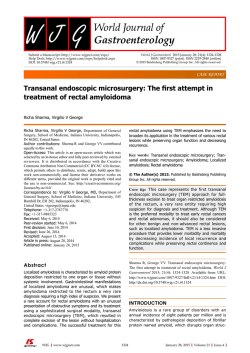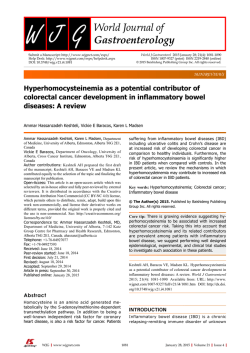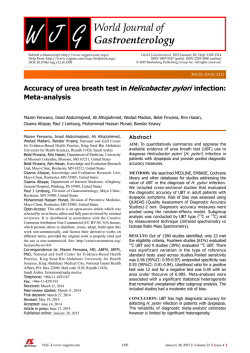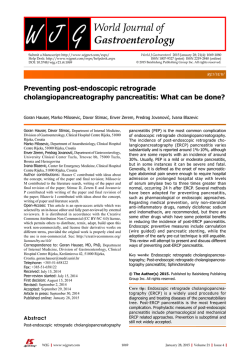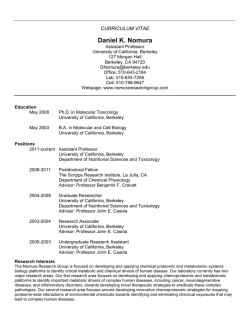
PDF (781K)
World J Gastroenterol 2015 January 28; 21(4): 1049-1052 ISSN 1007-9327 (print) ISSN 2219-2840 (online) Submit a Manuscript: http://www.wjgnet.com/esps/ Help Desk: http://www.wjgnet.com/esps/helpdesk.aspx DOI: 10.3748/wjg.v21.i4.1049 © 2015 Baishideng Publishing Group Inc. All rights reserved. EDITORIAL Does endoscopic ultrasound-guided biliary drainage really have clinical impact? Takeshi Ogura, Kazuhide Higuchi guided hepaticogastrostomy. More recently, EUS-gui ded antegrade stenting and EUS-guided gallbladder drainage have also been reported. many case reports, series, and retrospective studies on EUS-BD have been reported. However, because prospective studies and comparisons between the different biliary drainage methods have not been reported, the technical success, functional success, adverse events, and stent patency with long-term follow up of EUS-BD are still unclear. Therefore, prospective, randomized controlled studies addressing these issues are needed. Despite this, EUSBD undoubtedly is clinically useful as an alternative biliary drainage method. EUS-BD has the potential to be a first-line biliary drainage method instead of ERCP if results of clinical trials are favorable and the technique is simplified. Takeshi Ogura, Kazuhide Higuchi, Second Department of Internal Medicine, Osaka Medical College, Osaka 569-8686, Japan Author contributions: Ogura T and Higuchi K solely contributed to this paper. Conflict-of-interest: No potential conflicts of interest relevant to this article were reported. Open-Access: This article is an open-access article which was selected by an in-house editor and fully peer-reviewed by external reviewers. It is distributed in accordance with the Creative Commons Attribution Non Commercial (CC BY-NC 4.0) license, which permits others to distribute, remix, adapt, build upon this work non-commercially, and license their derivative works on different terms, provided the original work is properly cited and the use is non-commercial. See: http://creativecommons.org/ licenses/by-nc/4.0/ Correspondence to: Takeshi Ogura, MD, PhD, Second Department of Internal Medicine, Osaka Medical College, 2-7 Daigaku-machi, Takatsuki, Osaka 569-8686, Japan. [email protected] Telephone: +81-726-831221 Fax: +81-726-846532 Received: November 6, 2014 Peer-review started: November 7, 2014 First decision: November 26, 2014 Revised: November 29, 2014 Accepted: December 20, 2014 Article in press: December 22, 2014 Published online: January 28, 2015 Key words: Endoscopic ultrasound; Endoscopic ultrasoundguided biliary drainage; Endoscopic ultrasound-guided hepaticogastrostomy; Endoscopic ultrasound-guided choledochoduodenostomy; Endoscopic ultrasoundguided antegrade stenting; Endoscopic ultrasoundguided gallbladder drainage © The Author(s) 2015. Published by Baishideng Publishing Group Inc. All rights reserved. Core tip: To date, many case reports, series, and retrospective studies on EUS-guided biliary drainage (EUS-BD) have been reported. However, because prospective studies and comparisons between the different biliary drainage methods have not been reported, the technical success, functional success, adverse events, and stent patency with long-term follow up of EUS-BD are still unclear. Therefore, prospective, randomized controlled studies addressing these issues are needed. Despite this, EUS-BD undoubtedly is clinically useful. EUS-BD has the potential to be a firstline biliary drainage method instead of endoscopic retrograde cholangiopancreatography if results of clinical trials are favorable and the technique is simplified. Abstract The well established, gold standard method for treatment of obstructive jaundice involves biliary drainage under endoscopic retrograde cholangiopancreatography (ERCP) performed by pancreatobiliary endoscopists. Recently, interventions using endoscopic ultrasound (EUS) have been developed not only for obtaining cytological and histological diagnosis, but also for biliary drainage as alternative method. EUS-guided biliary drainage (EUSBD) was first reported by Giovannini et al . EUS-BD broadly includes EUS-guided rendezvous technique, EUS-guided choledochoduodenostomy, and EUS- WJG|www.wjgnet.com 1049 January 28, 2015|Volume 21|Issue 4| Ogura T et al . EUS-guided biliary drainage duct is punctured by a 19G needle, the guidewire is inserted, and the fistula is dilated using a needle knife, dilator, or balloon dilator. Finally, a fully covered metallic stent is usually placed from the common bile duct to the duodenum. High technical and clinical success rates of this procedure have been reported. The biggest advantage of this method is that it is not associated with acute pancreatitis. EUS-CDS, thus, has the potential to be the biliary drainage method of choice instead of ERCP, although this needs to be confirmed by a randomized controlled trial comparing ERCP and EUS-CDS. EUS-HGS has the widest indications among the different EUS-BD procedures. It can be performed in patients with altered anatomy, duodenal obstruction, [18] and hepatic hilar obstruction . In this procedure, the intrahepatic bile duct (segment 3) is punctured using a 19G needle, and the guidewire is advanced. Various devices are then used to dilate the fistula. [19] Park et al reported the predictors of adverse events with EUS-BD. In their study, post-procedure adverse events developed after EUS-BD in 11 patients (20%). Multivariate analysis demonstrated that use of a needle knife was the single most important risk factor for post-procedure adverse events after EUS-BD (OR = 12.4; P = 0.01). Hence, balloon or dilator catheters may be suitable for dilation of the fistula. In addition, metallic stents should also be used to avoid bile leakage. However, this technique is associated with the risk of fatal [20] adverse events, such as stent migration . If its adverse events can be minimized by various efforts, EUS-HGS may become the EUS-BD technique of choice because of its wide indications. EUS-AS may also be a promising drainage method. After the intrahepatic bile duct is punctured using a 19G needle, the guidewire is advanced through the site of obstruction. Thereafter, a stent deliverer is inserted and the stent is placed in a trans- or supra-papillary position. In this technique, compared with EUS-HGS, stent migration does not occur, indicating that it seems to be a safe technique. However, re-intervention following stent occlusion, if required, can be challenging. If occlusion of the EUSAS stent was to occur, we would need to do either of the following: puncture the intrahepatic bile duct and perform EUS-HGS, or place another stent inside the occluded stent. However, the intrahepatic bile duct may not always be dilated enough to allow for [21] puncturing . For this reason, EUS-AS should only be performed in selected patients, such as those with a limited prognosis. EUS-GBD is probably the most easily performed of all the EUS-BD procedures, because the ga llbladder presents a large target for puncture. The gallbladder can be visualized from the antrum or duodenal bulb. After it is punctured using a 19G needle, the guidewire is inserted. Then, the fistula Ogura T, Higuchi K. Does endoscopic ultrasound-guided biliary drainage really have clinical impact? World J Gastroenterol 2015; 21(4): 1049-1052 Available from: URL: http://www. wjgnet.com/1007-9327/full/v21/i4/1049.htm DOI: http://dx.doi. org/10.3748/wjg.v21.i4.1049 INTRODUCTION The well established, gold standard method for treatment of obstructive jaundice involves biliary drainage under endoscopic retrograde cholangio pancreatography (ERCP) performed by pancrea [1-3] tobiliary endoscopists . Percutaneous trans hepatic cholangiography (PTC) has also been established as an alternative method for biliary [4,5] drainage . However, PTC is associated with several complications, such as cholangitis, bile leakage, and pneumothorax. Moreover, the frequency of major complications, leading to prolonged hospital stay and permanent adverse sequelae, is 4.6%-25%, [4,5] and that of procedure-related deaths is 0%-5.6% . Cosmetic issues due to external drainage also com promise the patient’s quality of life. Moreover, a large amount of ascites is a contraindication for PTC. Recently, interventions using endoscopic ultrasound (EUS) have been developed not only for obtaining cytological and histological diagnosis (EUS-guided fine needle aspiration), but also for biliary drainage. EUS-guided biliary drainage (EUS-BD) was first [6] reported by Giovannini et al . EUS-BD broadly includes EUS-guided rendezvous technique (EUS[7,8] RV) , EUS-guided choledochoduodenostomy (EUS[9,10] CDS) , and EUS-guided hepaticogastrostomy [11,12] (EUS-HGS) . Recently, EUS-guided antegrade [13,14] stenting (EUS-AS) and EUS-guided gallbladder [15,16] drainage (EUS-GBD) have also been reported. Technical evaluation of EUS-BD EUS-RV is mainly indicated for failed ERCP. This technique involves puncture of the intrahepatic or common bile duct using a 19G needle, following which a guidewire is advanced toward the duodenum through the site of stenosis or the ampulla of Vater. However, the technical success rate of this procedure [17] is not very high (70%-100%) . In addition, this technique is not indicated for cases of duodenal obstruction that are caused by tumor invasion, or those with altered anatomy, such as following the Roux-en-Y procedure. To enhance the technical success rate, the puncture needle and the guidewire should be stiff or include some additional technical features. EUS-CDS is also normally indicated for failed ERCP. Performance of EUS-CDS requires puncture of the extrahepatic bile duct; therefore, this technique is indicated in cases of duodenal obstruction that do not involve the duodenal bulb. The extrahepatic bile WJG|www.wjgnet.com 1050 January 28, 2015|Volume 21|Issue 4| Ogura T et al . EUS-guided biliary drainage [28] is dilated using a dilation or balloon catheter, while a pig tail type plastic stent is usually placed (sometimes combined with a metallic stent) to prevent stent migration. This technique is indicated in patients whose cystic duct is intact. If the cystic duct is invaded by tumor, stent dysfunction can occur. Although EUS-CDS or EUS-HGS is usually performed in cases requiring re-intervention, the patient’s condition may not be suitable for re-intervention because of tumor progression. In such cases, when performance of EUS-CDS or EUS-HGS is challenging, EUS-GBD may be performed. To date, there are no reports of randomized controlled studies comparing ERCP with EUS-BD. However, recently, a retrospective study comparing [22] PTC and EUS-BD has been reported . In this paper, of the 73 patients with failed ERCP complicated by distal malignant biliary obstruction who were included, EUS-BD was performed in 22 patients and PTC in 51 patients. Although the technical success rate of PTC was higher than that of EUS-BD, the adverse event rate and total cost were also higher than those of EUS-BD. Interestingly, EUS-BD is associated with a decreased adverse event rate and is significantly less costly due to the need for fewer re-interventions. However, these results should be further evaluated in a prospective clinical trial. ends of the covered portion. Paik et al described a simplified and modified technique of EUS-HGS, which resulted in a shorter procedural time (P < 0.001) and less frequent early adverse events (P = 0.02) compared with the conventional technique. Yet, [29] although various techniques have been reviewed , the best techniques and devices still need to be determined by a prospective study. CONCLUSION In conclusion, to date, many case reports, series, and retrospective studies on EUS-BD have been reported. However, because prospective studies and comparisons between the different biliary drainage methods have not been reported, the technical success, functional success, adverse events, and stent patency with long-term follow up of EUS-BD are still unclear. Therefore, prospective, randomized controlled studies addressing these issues are needed. Despite this, EUS-BD undoubtedly is clinically useful as an alternative biliary drainage method. EUS-BD has the potential to be a first-line biliary drainage method instead of ERCP if results of clinical trials are favorable and the technique is simplified. REFERENCES Techniques to minimize adverse events following EUSBD 1 According to recent literature reviews of EUS-BD, the adverse event rates of these procedures are still [17] high . Reportedly, several techniques and devices have been introduced to reduce the adverse event rates. In EUS-CDS or EUS-GBD, novel metallic stents have been used to prevent stent migration. Itoi [23] et al reported the technique of EUS-GBD using AXIOS stent (Xlumena Inc., Mountain View, CA, United States). This stent is a fully covered, 10 mm diameter, 10 mm long braided stent with bilateral 20 [24] mm diameter anchor flanges. Perez-Miranda et al reported using this novel stent for EUS-CDS. This unique stent design may be effective in preventing [25] stent migration. In addition, Teoh et al described a simplified method of EUS-GBD using a novel cauterytipped stent delivery system. However, since use of these novel stents or methods has only been reported as case reports, additional case studies and trials are required for further development of EUSCDS and EUS-GBD as safe, simple, and effective biliary drainage methods. Likewise, several methods for improving the results of EUS-HGS have also been reported. The clinical impact of EUS-HGS [21] combined with EUS-AS and a novel method of [26] stent placement of EUS-HGS have been previously [27] reported. Recently, Song et al performed 10 EUSHGS cases using a novel hybrid metallic stent that has proximal and distal antimigration flaps at both WJG|www.wjgnet.com 2 3 4 5 6 7 8 9 1051 Cotton PB. Cannulation of the papilla of Vater by endoscopy and retrograde cholangiopancreatography (ERCP). Gut 1972; 13: 1014-1025 [PMID: 4568802 DOI: 10.1136/gut.13.12.1014] ASGE guidelines for clinical application. The role of ERCP in diseases of the biliary tract and pancreas. American Society for Gastrointestinal Endoscopy. Gastrointest Endosc 1999; 50: 915-920 [PMID: 10644191 DOI: 10.1016/S0016-5107(99)70195-1] Fogel EL, Sherman S, Devereaux BM, Lehman GA. Therapeutic biliary endoscopy. Endoscopy 2001; 33: 31-38 [PMID: 11204985 DOI: 10.1055/s-2001-11186] Günther RW, Schild H, Thelen M. Percutaneous transhepatic biliary drainage: experience with 311 procedures. Cardiovasc Intervent Radiol 1988; 11: 65-71 [PMID: 2455599 DOI: 10.1007/ BF02577061] Carrasco CH, Zornoza J, Bechtel WJ. Malignant biliary obstruction: complications of percutaneous biliary drainage. Radiology 1984; 152: 343-346 [PMID: 6739796 DOI: 10.1148/radiology.152.2.6739796] Giovannini M, Moutardier V, Pesenti C, Bories E, Lelong B, Delpero JR. Endoscopic ultrasound-guided bilioduodenal anastomosis: a new technique for biliary drainage. Endoscopy 2001; 33: 898-900 [PMID: 11571690] Isayama H, Nakai Y, Kawakubo K, Kawakami H, Itoi T, Yamamoto N, Kogure H, Koike K. The endoscopic ultrasonography-guided rendezvous technique for biliary cannulation: a technical review. J Hepatobiliary Pancreat Sci 2013; 20: 413-420 [PMID: 23179560 DOI: 10.1007/s00534-012-0577-8] Dhir V, Bhandari S, Bapat M, Maydeo A. Comparison of EUSguided rendezvous and precut papillotomy techniques for biliary access (with videos). Gastrointest Endosc 2012; 75: 354-359 [PMID: 22248603 DOI: 10.1016/j.gie.2011.07.075] Hara K, Yamao K, Hijioka S, Mizuno N, Imaoka H, Tajika M, Kondo S, Tanaka T, Haba S, Takeshi O, Nagashio Y, Obayashi T, Shinagawa A, Bhatia V, Shimizu Y, Goto H, Niwa Y. Prospective clinical study of endoscopic ultrasound-guided choledochoduodenostomy with direct metallic stent placement January 28, 2015|Volume 21|Issue 4| Ogura T et al . EUS-guided biliary drainage 10 11 12 13 14 15 16 17 18 19 20 using a forward-viewing echoendoscope. Endoscopy 2013; 45: 392-396 [PMID: 23338620 DOI: 10.1055/s-0032-1326076] Song TJ, Hyun YS, Lee SS, Park do H, Seo DW, Lee SK, Kim MH. Endoscopic ultrasound-guided choledochoduodenostomies with fully covered self-expandable metallic stents. World J Gastroenterol 2012; 18: 4435-4440 [PMID: 22969210 DOI: 10.3748/wjg.v18.i32.4435] Ogura T, Masuda D, Imoto A, Umegaki E, Higuchi K. EUSguided gallbladder drainage and hepaticogastrostomy for acute cholecystitis and obstructive jaundice (with video). Endoscopy 2014; 46 Suppl 1 UCTN: E75-E76 [PMID: 24639366 DOI: 10.1055/s-0033-1359135] Park do H. Endoscopic ultrasonography-guided hepaticogas trostomy. Gastrointest Endosc Clin N Am 2012; 22: 271-80, ix [PMID: 22632949 DOI: 10.1016/j.giec.2012.04.009] Artifon EL, Safatle-Ribeiro AV, Ferreira FC, Poli-de-Figueiredo L, Rasslan S, Carnevale F, Otoch JP, Sakai P, Kahaleh M. EUS-guided antegrade transhepatic placement of a self-expandable metal stent in hepatico-jejunal anastomosis. JOP 2011; 12: 610-613 [PMID: 22072253] Ogura T, Edogawa S, Imoto A, Masuda D, Yamamoto K, Takeuchi T, Inoue T, Uchiyama K, Higuchi K. EUS-guided hepaticojejunostomy combined with antegrade stent placement. Gastrointest Endosc 2014; Epub ahead of print [PMID: 25038002 DOI: 10.1016/j.gie.2014.05.323] Hara K, Yamao K, Niwa Y, Sawaki A, Mizuno N, Hijioka S, Tajika M, Kawai H, Kondo S, Kobayashi Y, Matumoto K, Bhatia V, Shimizu Y, Ito A, Hirooka Y, Goto H. Prospective clinical study of EUS-guided choledochoduodenostomy for malignant lower biliary tract obstruction. Am J Gastroenterol 2011; 106: 1239-1245 [PMID: 21448148 DOI: 10.1016/j.gie.2011.03.1120] Itoi T, Coelho-Prabhu N, Baron TH. Endoscopic gallbladder drainage for management of acute cholecystitis. Gastrointest Endosc 2010; 71: 1038-1045 [PMID: 20438890 DOI: 10.1016/ j.gie.2010.01.026] Fabbri C, Luigiano C, Lisotti A, Cennamo V, Virgilio C, Caletti G, Fusaroli P. Endoscopic ultrasound-guided treatments: are we getting evidence based--a systematic review. World J Gastroenterol 2014; 20: 8424-8448 [PMID: 25024600 DOI: 10.3748/wjg.v20. i26.8424] Ogura T, Sano T, Onda S, Imoto A, Masuda D, Yamamoto K, Kitano M, Takeuchi T, Inoue T, Higuchi K. Endoscopic ultrasoundguided biliary drainage for right hepatic bile duct obstruction: novel technical tips. Endoscopy 2015; 47: 72-75 [PMID: 25264761] Park do H, Jang JW, Lee SS, Seo DW, Lee SK, Kim MH. EUSguided biliary drainage with transluminal stenting after failed ERCP: predictors of adverse events and long-term results. Gastrointest Endosc 2011; 74: 1276-1284 [PMID: 21963067 DOI: 10.1016/j.gie.2011.07.054] Martins FP, Rossini LG, Ferrari AP. Migration of a covered metallic stent following endoscopic ultrasound-guided hepa ticogastrostomy: fatal complication. Endoscopy 2010; 42 Suppl 2: E126-E127 [PMID: 20405376 DOI: 10.1055/s-0029-1243911] 21 Ogura T, Masuda D, Imoto A, Takeushi T, Kamiyama R, Mohamed M, Umegaki E, Higuchi K. EUS-guided hepaticogastrostomy combined with fine-gauge antegrade stenting: a pilot study. Endoscopy 2014; 46: 416-421 [PMID: 24573771 DOI: 10.1055/ s-0034-1365020] 22 Khashab MA, Valeshabad AK, Afghani E, Singh VK, Kumbhari V, Messallam A, Saxena P, El Zein M, Lennon AM, Canto MI, Kalloo AN. A Comparative Evaluation of EUS-Guided Biliary Drainage and Percutaneous Drainage in Patients with Distal Malignant Biliary Obstruction and Failed ERCP. Dig Dis Sci 2014; Epub ahead of print [PMID: 25081224] 23 Itoi T, Binmoeller K, Itokawa F, Umeda J, Tanaka R. Endoscopic ultrasonography-guided cholecystogastrostomy using a lumenapposing metal stent as an alternative to extrahepatic bile duct drainage in pancreatic cancer with duodenal invasion. Dig Endosc 2013; 25 Suppl 2: 137-141 [PMID: 23617665 DOI: 10.1111/ den.12084] 24 Perez-Miranda M, De la Serna Higuera C, Gil-Simon P, Her nandez V, Diez-Redondo P, Fernandez-Salazar L. EUS-guided choledochoduodenostomy with lumen-apposing metal stent after failed rendezvous in synchronous malignant biliary and gastric outlet obstruction (with video). Gastrointest Endosc 2014; 80: 342; discussion 343-344 [PMID: 24814773 DOI: 10.1016/ j.gie.2014.03.010.] 25 Teoh AY, Binmoeller KF, Lau JY. Single-step EUS-guided puncture and delivery of a lumen-apposing stent for gallbladder drainage using a novel cautery-tipped stent delivery system. Gastrointest Endosc 2014; 80: 1171 [PMID: 24830582 DOI: 10.1016/j.gie.2014.03.038] 26 Ogura T, Kurisu Y, Masuda D, Imoto A, Hayashi M, Malak M, Umegaki E, Uchiyama K, Higuchi K. Novel method of endoscopic ultrasound-guided hepaticogastrostomy to prevent stent dysfunction. J Gastroenterol Hepatol 2014; 29: 1815-1821 [PMID: 24720511 DOI: 10.1111/jgh.12598] 27 Song TJ, Lee SS, Park do H, Seo DW, Lee SK, Kim MH. Preliminary report on a new hybrid metal stent for EUS-guided biliary drainage (with videos). Gastrointest Endosc 2014; 80: 707-711 [PMID: 25053527 DOI: 10.1016/j.gie.2014.05.327] 28 Paik WH, Park do H, Choi JH, Choi JH, Lee SS, Seo DW, Lee SK, Kim MH, Lee JB. Simplified fistula dilation technique and modified stent deployment maneuver for EUS-guided hepaticogastrostomy. World J Gastroenterol 2014; 20: 5051-5059 [PMID: 24803818 DOI: 10.3748/wjg.v20.i17.5051] 29 Prichard D, Byrne MF. Endoscopic ultrasound guided biliary and pancreatic duct interventions. World J Gastrointest Endosc 2014; 6: 513-524 [PMID: 25400865 DOI: 10.4253/wjge.v6.i11.513] P- Reviewer: Albuquerque A, Chow WK, Guarneri F, Kurtoglu E, Kouraklis G, Luo HS, Sulkowski S S- Editor: Qi Y L- Editor: A E- Editor: Zhang DN WJG|www.wjgnet.com 1052 January 28, 2015|Volume 21|Issue 4| Published by Baishideng Publishing Group Inc 8226 Regency Drive, Pleasanton, CA 94588, USA Telephone: +1-925-223-8242 Fax: +1-925-223-8243 E-mail: [email protected] Help Desk: http://www.wjgnet.com/esps/helpdesk.aspx http://www.wjgnet.com I S S N 1 0 0 7 - 9 3 2 7 0 4 9 7 7 1 0 0 7 9 3 2 0 45 © 2015 Baishideng Publishing Group Inc. All rights reserved.
© Copyright 2025
